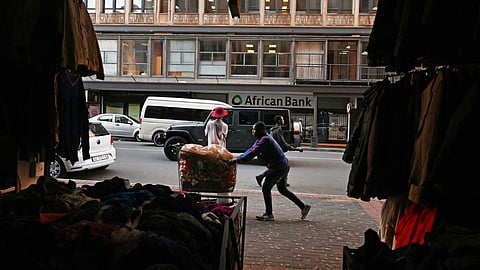Catch 22 for SARB policymakers – an erosion of basic monetary policy
Colleen Goko highlights a severe crisis that South Africa is facing which is challenging a fundamental principle of monetary policy. An energy crisis, sluggish economic growth, and deteriorating fiscal indicators have led to a record low value of the rand, but the conventional response of raising interest rates to stabilize the currency may prove detrimental to the fragile economy and further weaken the rand. The rand's recent decline, exacerbated by arms-to-Russia allegations and inflation concerns, has raised speculation about additional interest rate hikes. The Reserve Bank is now facing a difficult choice between rate hikes that may harm the rand or pausing the tightening cycle, which could also undermine the currency.
South Africa Crisis Is Eroding a Basic Rule of Monetary Policy
By Colleen Goko
Things have got so bad in South Africa that one of the fundamental laws of monetary policy is beginning to weaken, and even break.
A crippling energy crisis, a low growth environment and deteriorating fiscal metrics combined to push the rand to a record low last week.
But the normal response of raising interest rates to defend the currency may prove counterproductive, undermining a fragile economy and pushing the rand even lower, according to economists at Goldman Sachs International. The South African Reserve Bank wants to support the rand to cut the cost of imports and ease pressure on inflation.
Tighter monetary policy risks "creating a feedback loop for the rand," Andrew Matheny and Bojosi Morule wrote in a note to clients. "The risk of overtightening in the face of FX pressure is real and could ultimately undermine the SARB's policy response."
The rand on Friday reached 19.5148 per US dollar amid diplomatic tensions over US accusations that Pretoria helped ship arms to Russia. That sent inflation expectations above the central bank's target range of between 3% and 6%. It also stoked speculation over more interest rate hikes after the May 25 decision.
South Africa Central Bank Rate at 8.00% by End-3Q (Survey)
Matheny and Morule raised their forecast and now expect the central bank to deliver a 50 basis-point hike to 8.25%. Cuts will only begin in the second quarter of 2024, they said.
The central bank has already delivered 425 basis points of tightening since November 2021, with March's bigger-than-expected 50 basis-point increase the latest move.
The central bank is now in a tough position, with both rate hikes and a pause to the tightening cycle both potentially undermining the rand.
"If the SARB doesn't hike, or even does a 25 basis-point hike, versus the market that is pricing in 50 basis points, we are likely to see some rand weakness," said Walter de Wet, an analyst at Nedbank Group Ltd.
The best policymakers can hope for is avoiding rand weakness, rather than strengthening the currency through rate hikes, he said.
"SARB is in a really tough position," said Win Thin, global head of currency strategy at Brown Brothers Harriman & Co. "Inflation and the weak rand warrant more rate hikes but the economy is already suffering from power shortages. I think they want to stop hiking soon but I'm not sure the market will let them."
The rand fell as much as 1.3% to 19.3215 per dollar in Johannesburg Wednesday. It led the selloff in emerging markets prompted by the US debt drama and weak China data.
Read also:
© 2023 Bloomberg L.P.

